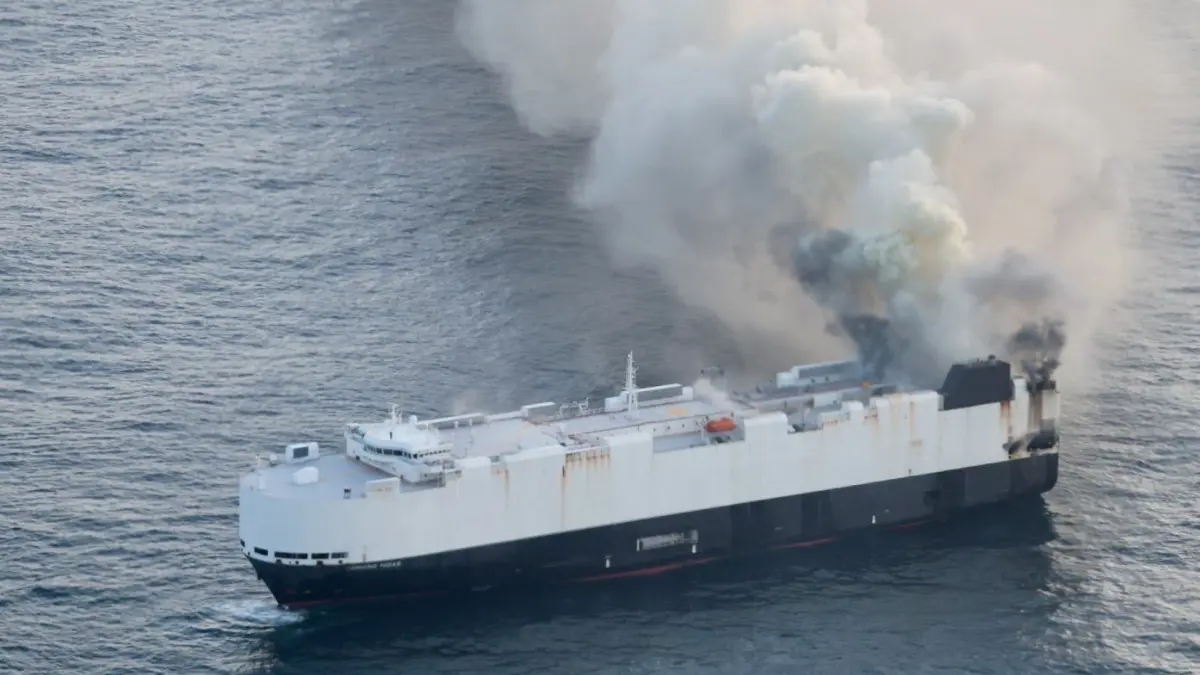Critical Incident Details
A big cargo ship carrying 3,048 cars from China to Mexico sank in the North Pacific Ocean on June 23. This incident occurred just a few weeks after a fire broke out on the ship, prompting the crew to evacuate the vessel for safety.
Morning Midas Cargo Ship Sinks in international waters about 450 miles southwest of Adak, Alaska. It went down to a depth of around 16,400 feet, which is quite deep underwater.
The U.S. Coast Guard announced that they received a report at 5:35 p.m. on Monday about a ship that had capsized and then sunk. The ship, named Morning Midas, was managed by Zodiac Maritime, a shipping company based in London.
Vessel and Cargo Details
A large ship, approximately 600 feet (183 meters) long, was built in 2006 and sailed under the Liberian flag. It started its journey from Yantai, China, on May 26 and was heading to the Mexican port of Lázaro Cárdenas.
The ship was transporting a total of 3,048 vehicles, which included about 70 electric cars that run solely on electricity and 681 hybrid cars that use both gasoline and electricity.
“The ship was carrying 350 tons of marine gas oil and 1,530 tons of very low sulfur fuel oil when the incident occurred.”
Fire Origin and Electric Vehicle Connection
“On June 3, a fire broke out on the ship while it was located approximately 360 nautical miles southwest of Adak Island, which is about 1,200 miles west of Anchorage, Alaska.“
“Officials noticed a big cloud of smoke coming from the back of the ship, where the electric vehicles were kept. The batteries used in these cars can catch fire if they are damaged, which is a known safety concern.”
“Even though the crew tried hard to use their emergency firefighting measures and onboard systems to control the blaze, the fire became so intense that all 22 crew members had to leave the ship.”
Crew Safety and Sinking in Morning Midas Cargo Ship
All 22 crew members on the ship Morning Midas were able to escape safely to lifeboats on June 5. They were rescued by a nearby container ship called COSCO Hellas. The Coast Guard reported that everyone was unharmed during the rescue.
A ship sank around 4:35 PM local time on June 23, in deep waters about 360 nautical miles from shore, where the ocean is about 5,000 meters deep. The situation worsened after a fire broke out on board, and rough weather made things even more difficult, causing water to enter the vessel until it ultimately sank.
Get more insights here – Car Carrier Morning Midas Sinks in North Pacific
Salvage and Environmental Response
Rescue operations began soon after the evacuation. A group from Resolve Marine, the same company that helped clean up after the Francis Scott Key Bridge collapse in Baltimore, was brought in to assist.
Two rescue tugboats, named Garth Foss and Salvage Worker, arrived a few days after a fire damaged a ship. These tugboats are equipped with specialized tools to help prevent pollution. They are still at the location, keeping an eye out for any oil spills or debris floating in the water.
“There doesn’t seem to be any pollution visible,” said Cameron Snell, a spokesperson for the U.S. Coast Guard in Alaska. “At the moment, we also have boats nearby ready to deal with any pollution if it appears.”
Official Response on Morning Midas Cargo Ship Sinks
“The safety of our responders is our highest concern,” said Captain Christopher Culpepper, who leads the Coast Guard Sector in Western Alaska and the U.S. Arctic. “We are teaming up with Zodiac Maritime to help make sure we respond quickly and effectively if we see any signs of pollution.”
“Officials recently announced that all activities are focused on keeping people safe and caring for the ocean’s health.”
Industry Context
“This event has shown us the fire dangers associated with lithium-ion batteries used in electric cars.“
The Morning Midas incident is just one of several recent fires involving car carriers. Other notable cases include the Fremantle Highway in 2023, the Felicity Ace in 2022, and the Sincerity Ace in 2018. Out of these ships, only the Felicity Ace ended up sinking.”
The growing demand for lithium-ion batteries, particularly for electric vehicles (EVs), is presenting new challenges for the global shipping industry. This is especially important since the cars transported on large ships are often very valuable, according to a recent report from the insurance company Allianz.
A recent report by a Dutch safety board has highlighted the need for improved emergency response procedures on shipping routes. This comes after a ship fire in 2023 that involved 3,000 vehicles, including about 500 electric cars. The fire burned for a week and unfortunately led to one death and several injuries.
Read more news –
